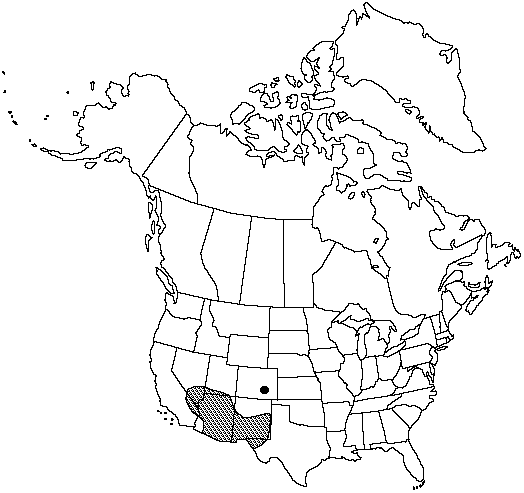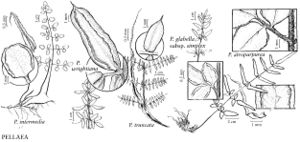Pellaea truncata
Muhlenbergia 8: 94. 1912.
Stems compact, ascending, stout, 5–10 mm diam.; scales bicolored, linear-subulate, 0.1–0.3 mm wide, centers black, thick, margins brown, thin, erose-dentate. Leaves somewhat dimorphic, sterile leaves shorter and less divided than fertile leaves, clustered on stems, 8–40 cm; croziers sparsely villous. Petiole dark brown, lustrous, flattened or slightly grooved adaxially, without prominent articulation lines. Blade ovate-deltate, usually 2-pinnate proximally, 4–18 cm wide; rachis brown throughout, straight, shallowly grooved adaxially, usually glabrous. Pinnae perpendicular to rachis to slightly ascending, not decurrent on rachis, usually with 9–25 ultimate segments; costae straight, 20–70 mm, much longer than fertile ultimate segments. Ultimate segments narrowly oblong, 4–10 mm, leathery, glabrous; margins recurved on fertile segments, usually covering less than 1/2 abaxial surface, borders whitish, nearly entire; apex mucronate. Veins of ultimate segments obscure. Sporangia long-stalked, containing 64 spores, intermixed with abundant farina-producing glands. 2n = 58.
Phenology: Sporulating late spring–fall.
Habitat: Cliffs and rocky slopes, on various substrates but rarely observed on limestone
Elevation: 600–2500 m
Distribution

Ariz., Calif., Colo., Nev., N.Mex., Tex., Utah, n Mexico.
Discussion
Most manuals refer to Pellaea truncata as P. longimucronata, a name shown to be invalid by A. Cronquist et al. (1972+, vol. 1). Populations located near the range of P. mucronata in the Mojave Desert are often difficult to identify because of the subtlety of the characters involved and an apparent tendency to produce sterile (and possibly fertile) hybrids. Morphologically intermediate hybrids between P. truncata and P. wrightiana are common in regions where the ranges of the two species overlap, but these are easily identified by their malformed spores.
Selected References
None.
